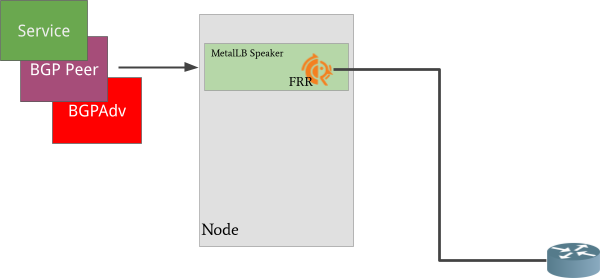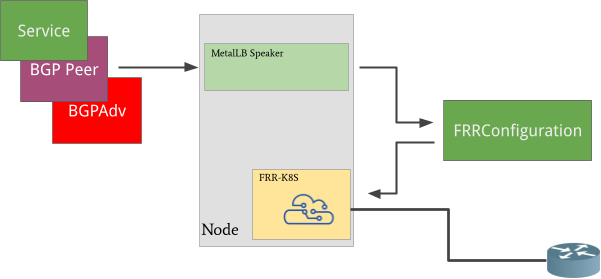The FRR-k8s API provides important Border Gateway Protocol (BGP) features required by the MetalLB load balancer with the ability to selectively accept routes and to inject raw FRR configuration options. It's built on FRRouting (FRR), a free and open source internet routing protocol suite for Linux and Unix platforms that implements Border Gateway Protocol (BGP) and Bidirectional Forwarding Detection (BFD).
Why you need FRR-k8s
MetalLB is a Kubernetes load balancer implementation that allows exposing Kubernetes services through BGP. The MetalLB project has replaced its native golang BGP implementation of MetalLB with FRR, and we've found that users want to leverage FRR for purposes beyond what MetalLB could do. For instance, a user might want to use a single FRR instance to receive routes on Kubernetes nodes through BGP. We've provided a short term solution, but we're also thinking about a cleaner way to leverage the same FRR instance to serve both MetalLB and other actors (such as users or another Kubernetes controller).
These goals have converged into a design proposal discussed and accepted by the community. The idea is to have an instance of FRR external to MetalLB, available through an API using CustomResourceDefinition (CRD), that's consumable from MetalLB but also available directly to the user. The design proposal has evolved in the implementation of a new project: FRR-k8s.
The community version of FRR-K8s is meant to be deployable as a standalone component, or it can be deployed together with MetalLB if its new FRR-K8s backend option is chosen, which is the main subject of this blog post.
The architecture
Currently, FRR runs as a sidecar container of the MetalLB speaker pod, which reconciles events from Kubernetes to the proper FRR configuration for the FRR instance running inside the pod.

On the other hand, when the BGP backend is implemented with FRR-K8s, MetalLB generates the proper configuration for FRR-K8s. This in turn translates that configuration into a valid configuration for its sidecar FRR container, which in turn implements the BGP protocol. For example:

Introduction to the FRR-K8s API
The FRRConfiguration CRD is used to configure an FRR instance. For example, the following configuration advertises a single prefix to a given neighbor, and allows all incoming prefixes to be accepted:
apiVersion: frrk8s.metallb.io/v1beta1
kind: FRRConfiguration
metadata:
name: example
namespace: FRR-k8s-system
spec:
bgp:
routers:
- asn: 64512
neighbors:
- address: 172.18.0.5
asn: 64512
toAdvertise:
allowed:
prefixes:
- 192.168.100.0/24
toReceive:
allowed:
mode: all
prefixes:
- 192.168.100.0/24
- 192.169.101.0/24We won’t cover all the details of the FRRConfiguration structure here, but here are the important points in this config:
- configures a BGP session with a given neighbor
- declares what prefixes are advertised for each neighbor
- declares what prefixes are accepted from a given neighbor
The FRRConfiguration CRD also comes with a node selector field that allows you to specify a configuration for a subset of nodes in a cluster:
apiVersion: frrk8s.metallb.io/v1beta1
kind: FRRConfiguration
metadata:
name: sample-node-selector
namespace: FRR-k8s-system
spec:
bgp:
routers:
- asn: 64512
neighbors:
- address: 172.30.0.3
asn: 64512
nodeSelector:
labelSelector:
foo: "bar"Experimental raw FRR configuration
It's still experimental, but the API also allows you to add a snippet of raw FRR configuration that's added after the one rendered by the daemon. The priority field determines what order multiple raw configurations are appended in. This is an experimental feature, so do not use it in production!
apiVersion: frrk8s.metallb.io/v1beta1
kind: FRRConfiguration
metadata:
name: sample-raw
namespace: FRR-k8s-system
spec:
raw:
priority: 5
rawConfig: |-
router bgp 64512
neighbor 172.18.0.5 remote-as 4200000000
neighbor 172.18.0.5 timers 0 0
neighbor 172.18.0.5 port 179The FRRNodeState resource
The FRR-K8s daemon generates an FRRNodeState instance for each node it’s running on.
apiVersion: frrk8s.metallb.io/v1beta1
kind: FRRNodeState
metadata:
name: FRR-k8s-worker
spec: {}
status:
lastConversionResult: success
lastReloadResult: success
runningConfig: |
Building configuration...
Current configuration:
!
frr version 8.4.2_git
frr defaults traditional
hostname FRR-k8s-worker
log file /etc/frr/frr.log informational
!
router bgp 64512
neighbor 172.18.0.5 remote-as 64512The status lists:
- result of processing all the FRRConfigurations applicable to a given node
- result of applying the configuration to the FRR instance
- configuration that the FRR instance is currently running with
Merging multiple configurations together
So far, we've talked about the option to have multiple FRRConfigurations for a node, but we haven't explained how it works. This is how multiple FRRConfigurations can be merged together. When it comes to having multiple FRRConfigurations for a node, the guiding principles are:
- A configuration must be self-contained (it cannot rely on others)
- A configuration can only add to the existing state
- A more permissive configuration can override a less permissive one
It's possible to add a new neighbor to a router, or to advertise an additional prefix to a neighbor. However, there is no way to remove a component added by another configuration (for example, you can't remove a neighbor specified in another FRRConfiguration).
In some cases, there could be conflicting configurations that can't be applied together. For example:
- different ASN for the same router (in the same VRF)
- different ASN for the same neighbor (with the same IP and port)
- multiple BFD profiles with the same name, but different values
When the daemon cannot merge a set of configurations for a node, it reports the configuration as invalid (through metrics and the Status resource) and leaves the previous valid configuration in place.
Integration with MetalLB
When running Red Hat OpenShift in the new FRR-K8s mode, MetalLB does not directly configure the FRR instance by itself. Instead, it creates and manages the relevant FRRConfiguration, which in turn is handled by the FRR-K8s daemon.
Specifically, each MetalLB speaker consumes its K8s objects (BGPPeers, LoadBalancer Services, and so on) as usual, and generates a single FRRConfiguration from them. That FRRConfiguration is named metallb-<NODE-NAME> and has a selector to match only the node with that particular name. This ensures that a node consumes the MetalLB configuration coming only from its own speaker.
For example, suppose that a MetalLB speaker on a node named blognode has a BGPPeer:
apiVersion: metallb.io/v1beta2
kind: BGPPeer
metadata:
name: blogpeer
namespace: metallb-system
spec:
myASN: 64512
peerASN: 64512
peerAddress: 172.18.0.5A BGPAdvertisement advertises a LoadBalancer service with IP 192.168.10.100 to that peer. In this case, the MetalLB speaker would create the following FRRConfiguration:
apiVersion: frrk8s.metallb.io/v1beta1
kind: FRRConfiguration
metadata:
name: metallb-blognode
namespace: metallb-system
spec:
bgp:
routers:
- asn: 64512
neighbors:
- address: 172.18.0.5
asn: 64512
toAdvertise:
allowed:
mode: filtered
prefixes:
- 192.168.10.100/32
prefixes:
- 192.168.10.100/32The speaker continuously manages this FRRConfiguration, reacting to any changes to relevant Kubernetes objects, updating it accordingly.
How to use FRR-K8s in Red Hat OpenShift
As of OpenShift 4.16, the field bgpBackend has been added to the MetalLB Operator’s MetalLB CRD. By default, MetalLB is deployed in the usual FRR mode. To deploy it in FRR-K8s mode, set bgpBackend to FRR-k8s. Once it's set, the Operator deploys the FRR-k8s daemon on the cluster, and MetalLB consumes its API.
Conclusion
In this post, we've discussed FRR-k8s, its architecture, how it can be used to allow multiple actors to configure an FRR daemon on an OpenShift node, and how MetalLB can leverage it. FRR-k8s allows a node to act as an FRR BGP router in a Kubernetes-compliant manner. The API is fully documented in the README file of the community project's Git repo, and in the documentation for OpenShift 4.16.
執筆者紹介
類似検索
チャンネル別に見る
自動化
テクノロジー、チームおよび環境に関する IT 自動化の最新情報
AI (人工知能)
お客様が AI ワークロードをどこでも自由に実行することを可能にするプラットフォームについてのアップデート
オープン・ハイブリッドクラウド
ハイブリッドクラウドで柔軟に未来を築く方法をご確認ください。
セキュリティ
環境やテクノロジー全体に及ぶリスクを軽減する方法に関する最新情報
エッジコンピューティング
エッジでの運用を単純化するプラットフォームのアップデート
インフラストラクチャ
世界有数のエンタープライズ向け Linux プラットフォームの最新情報
アプリケーション
アプリケーションの最も困難な課題に対する Red Hat ソリューションの詳細
オリジナル番組
エンタープライズ向けテクノロジーのメーカーやリーダーによるストーリー
製品
ツール
試用、購入、販売
コミュニケーション
Red Hat について
エンタープライズ・オープンソース・ソリューションのプロバイダーとして世界をリードする Red Hat は、Linux、クラウド、コンテナ、Kubernetes などのテクノロジーを提供しています。Red Hat は強化されたソリューションを提供し、コアデータセンターからネットワークエッジまで、企業が複数のプラットフォームおよび環境間で容易に運用できるようにしています。
言語を選択してください
Red Hat legal and privacy links
- Red Hat について
- 採用情報
- イベント
- 各国のオフィス
- Red Hat へのお問い合わせ
- Red Hat ブログ
- ダイバーシティ、エクイティ、およびインクルージョン
- Cool Stuff Store
- Red Hat Summit

